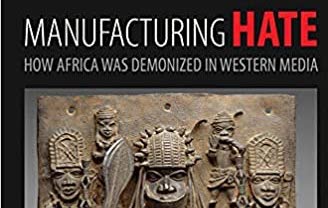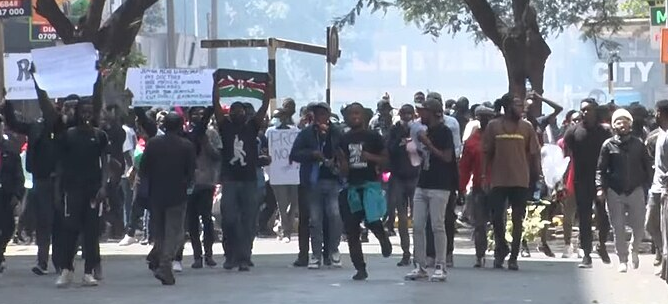[Book Review]
HOW AFRICA WAS DEMONIZED IN WESTERN MEDIA
Author: Milton Allimadi
Dubuque, IA, Kendall Hunt Publishing Company, 2021, 142p
Reviewed By: Georges Nzongola-Ntalaja
In his award-winning and highly acclaimed book, The Invention of Africa (1988), Congolese philosopher V.Y. Mudimbe provides a compelling analysis of how the idea of Africa was initially conceived by non-Africans as “a paradigm of difference.” By this he means the way Europeans looked at Africans as “the other” (Mudimbe 1988, and Mudimbe 1994). Even today, after students of human origins have conclusively shown that fully modern homo sapiens, the ancestors of all humanity, evolved entirely in Africa before spreading to other parts of the world, racists in the West and other parts of the world continue to believe in the inferiority of Black Africans and their descendants.
According to the American historian Christopher Ehret, the peoples of Africa “participated integrally in the great transformations of world history from the first rise of agricultural ways of life, to the various inventions of metalworking, to the growth and spread of global networks of commerce” (Ehret 2016:3). Ehret also shows how the Afrasian civilization, which originated in the Horn of Africa, expanded into the Ethiopian Highlands, and had a great impact on the Red Sea Hills and in Egypt. Contacts with the outside world before the Atlantic era were also established through the trans-Saharan trade involving the great West African empires and the historic scholarly center of Timbuktu, on the one hand, and through the trading city-states along the Indian Ocean coast, on the other.
Given this implication of Black Africa into the world system on largely equal terms, how did its demonization by non-Africans, and Westerners in particular, originate to become a major factor in the hatred and discrimination against Black Africans and their descendants until today? In Manufacturing Hate: How Africa Was Demonized in Western Media, Milton Allimadi provides excellent answers to this question, with mind-boggling examples of institutionalized racism from The New York Times and other major Western media. The book is divided into four parts, each examining a key aspect of the demonization of Africa, namely, (1) How the primitive image of Africa was created and universally disseminated; (2) How the great African military victories against European imperialists have been trivialized; (3) The covering of Africa by racist correspondents and editors of Western media; and (4) How Africa is relegated to the backwaters in these mass-consumption publications.
Allimadi is correct in tying the primitive image of the African by Westerners to “the expansion of the European capitalist economy on a global scale” (p. 4). To rationalize slave labor and the looting of Africa, the Africans themselves had to be dehumanized. For those who reaped benefits from slave labor like Thomas Jefferson, and the states and industrialists for whom the so-called explorers served as intelligence gatherers for Africa’s abundant natural resources, needed to dehumanize enslaved Africans and the inhabitants of the lands to be looted, respectively. Owned or sponsored by capitalist entrepreneurs, Western media treated Africa as a case of isolation and difference. With their very humanity denied, Black Africans were portrayed as “barbarians,” “primitives,” “tribal people,” “uncivilized,” and “peoples without history.”
One of the most idiotic acts of the European intelligence gatherers was their claim of “discovering” rivers, lakes, and mountains, which they then baptized with the names of their kings, queens, or other illustrious persons, when these natural sites already had local names. For example, Samuel Baker renamed the lake known as Luta N’zige, one of the sources of the River Nile on the border of Uganda and the Congo, “Lake Albert,” in honor of the husband of Queen Victoria, the British monarch. Unfortunately, the rulers of postcolonial Africa have kept most of these European-given names, including Victoria Falls, Lake Victoria, and Lake Edward.
Another interesting example of European arrogance and its limits is shown in chapter 4 of Manufacturing Hate, in which Allimadi recounts the conversation between Baker and Comoro, an elder and an organic intellectual of the Lotuko people of South Sudan. In this encounter between Baker, an allegedly superior human, and an African “savage,” it was the latter and not Baker who won virtually all the arguments. Of the two, it was the African who grounded his discourse in material reality instead of superstition.
Likewise, Allimadi shows how the European myth of African docility is contradicted by armed resistance to the colonial conquest by great African warriors such as Muhammad Ahmad al-Mahdi of Sudan, Samori Ture of what is today Guinea, and Empress Taytu Betul and Emperor Menelik II of Ethiopia. The victories at Khartoum and Adwa are discussed at length in Part II of the book. The author is obviously happy to celebrate the victories of African armies over better equipped European imperialists, but also to “dispel the myth of imperial invincibility and the canard that Africans welcomed European domination” (p. 42).
While acknowledging the charisma and popularity of the Mahdi, Allimadi does not place the Mahdist movement in Sudan within the overall Sufi resistance to European colonialism in the 19th century, which includes Samori Ture and other jihadists like Al-Hajj Umar Tall of the Tukulor Empire. As a Nubian Sufi leader of the Samaniyya order, Muhmmad Ahmad defeated the Egyptians in 1883 and was declared the Mahdi. His next challenge, and a very big one, was his ten-month siege of British and Egyptian forces in Khartoum, Sudan, who were commanded by the highly decorated General Charles George Gordon, nicknamed “Chinese Gordon” for his exploits in China. The Mahdists defeated his army and killed him on January 26, 1885. Mahdi died unexpectedly five months later, but his Dervish state survived for 13 years under his successor, Abdullah ibn Muhammad al-Khalifa, until the defeat of the Mahdists at the Battle of Omdurman in 1898 by General Horatio Herbert Kitchener.
The other glorious victory over imperialism was the one engineered by Empress Taytu and Emperor Menelik II at the Battle of Adwa, where an Italian army of 17,000 troops was annihilated in a single day, between 6:00 a.m. and noon on March 1,1896. With the Ethiopians using European weapons of the same quality as those of the Italians, this encounter demonstrated that given the same arsenal, Africans could, with appropriate strategy and devotion to the task at hand, defeat European armies. Adwa is widely celebrated across Africa and in the African diaspora worldwide as “Africa’s victory.” On the other hand, falsifying reality in the name of “the manifest destiny” of the white man, The New York Times, as cited by Allimadi, depicted the attempted Italian conquest as a noble task designed to impose “civilization and Christianity over barbarians and savages, over unbelief, over habits of ferocity, over brutal ignorance of every human law, religious, social, and civil” (p. 47). As Allimadi points out, Christianity was established as Ethiopia’s state religion in 330 CE. Ironically, the newspaper clearly indicated in the same article the real Italian objectives, which were mainly economic, and the main reason why the Times was behind colonial conquests in Africa.
Italy’s defeat in Ethiopia was greatly felt as humiliation, not only for being denied access to Ethiopia’s economic and strategic assets, but also for a white country to be defeated by a black one. Benito Mussolini, the Italian Fascist dictator, could not rest until he could avenge the humiliation of 1896. With large armies in its neighboring colonies of Eritrea and Italian Somalia, Mussolini had no great difficulty invading Ethiopia on October 3, 1935, with 30,000 troops, 1,000 trucks, and large supplies of mustard gas. Once again, The New York Times of May 6, 1936, applauded Mussolini’s show of force with fifty planes flying over Addis Ababa, the Ethiopia’s capital, forcing Emperor Haile Selassie to leave the capital and go into exile. The Italians committed heinous war crimes and crimes against humanity, with their reckless use of mustard gas and the imposition of a veritable reign of terror all over the country.
Allimadi’s discussion of the retaliation against Mussolini’s occupation of Ethiopia between 1935 and 1941 is incomplete, since he devotes only one paragraph of chapter 8 to this important fight for the recovery of the sovereignty of a state that had been in existence since Biblical times. It is true that the mobilization of African American and Afro-Caribbean volunteers for military action in Ethiopia did present enormous logistical challenges, but some of these men did make it to the Motherland to fight Italians, as shown in Joseph E. Harris’s book African-American Reactions to War in Ethiopia, 1936-1941. The father of the late Howard University professor Abiyi Ford was one of them.
The author credits the defeat of Mussolini’s army in 1941 to “British forces in Africa … fighting with Ethiopian guerrillas” (p. 54). But this not the whole story. The Allies had entrusted this task to the British because of the latter’s colonial presence in the Anglo-Egyptian Sudan, British Somaliland, Kenya, and Uganda. Thus, except for officers, the “British forces” in question were mostly Africans from these colonies and those from Nigeria and Southern Rhodesia, plus troops from India. A very important addition to the Abyssinian Campaign of 1941 was a large contingent from the Belgian Congo, solicited by the British from the Governor General of the colony, with the obvious accord of the useless Belgian government in exile in London, financed to the tune of £40 million by its rich colony.
On February 29, 2012, I received an email from Lensa Idossa, an Ethiopian student at Columbia University, asking me to explain why there is a place in his town of Dembi Dollo in Western Ethiopia called “The Congo Cemetery.” I replied that hundreds of Congolese soldiers from the Force Publique (FP), the colonial army, had died to free Ethiopia from Italian Fascism. Three major victories were won by the Congolese as follows: March 11, 1941, at Asosa; March 23 at Gambela; and July 3 at Saïo, which is now known as Dembi Dollo. Here, nine Italian generals, one colonel, 370 officers, 2,574 Italian noncommissioned officers and soldiers, and 1,533 Eritrean noncommissioned officers and soldiers surrendered to the FP. Thus, if the Battle of Gondar under British command in November 1941 was the ultimate defeat of Italy in Ethiopia, its capitulation to the Belgian Congo at Saïo had been a blow from which it could not recover fully. More than 500 Congolese lost their lives during the “Abyssinian Campaign,” including 245 soldiers (of which 42 were killed on the battlefield and 195 due to gun wounds or disease) and 274 porters.
For two years after my email exchange with Lensa Idossa, a patriotic fire inside kept urging me to visit the battlefields where Congolese soldiers fought in 1941. I finally found my way to Western Ethiopia with a three-day visit to Gambela, August 2-5, 2014, including a full-day trip to Dembi Dollo, site of the FP’s greatest victory and the “Congo Cemetery,” on August 3, and a two-day trip to Asosa from August 6-8. These visits were all very disappointing. Except for the Ethiopian citizens who were kind enough to show me around, there were no plaques for the battlefields and the cemetery in Dembi Dollo. Some of the graves were still visible but the whole area was simply bush and likely to disappear if the Ethiopian and Congolese governments fail to honor this burial ground. If Allimadi is correct about the trivializing of Africa’s military victories by Western media, African governments must also be blamed for neglecting to mark the sites where they took place for historical memory and to honor the soldiers who died there.
Part Three of the book focuses on biased reporting on Africa by Western media, with examples from The New York Times, Time magazine and other publications, most of which were for a long time supporters of the apartheid system of white supremacy in South Africa. Freedom fighters like the Kenyans of the Land and Freedom Party, who were derogatorily referred to as “Mau Mau,” their counterparts in the fight against settler colonialism in Southern Rhodesia (now Zimbabwe), South Africa, and South West Africa (now Namibia), as well as those fighting against Portuguese Fascism and ultra-colonialism were invariably called “terrorists.” The crimes committed by the white minority regimes in settler states and the Portuguese in Angola, Guinea-Bissau and Mozambique were more savage than what the freedom fighters were accused of. Allimadi relates information from hearings by UK courts with documented evidence of “barbaric forms of torture by the British colonial authorities” during the “Emergency” in Kenya between 1952 and 1956.
In the case of the Congo, it is a bit of an exaggeration to say that “Mobutu handed Lumumba over to Tshombe” (p. 76) because the assassination of Patrice Lumumba was a joint undertaking by the United States and Belgium, and Moise Tshombe was a Belgian puppet whose Katanga province was under the full control of Belgian civil servants and military officers. Moreover, Tshombe did not “preside” over Lumumba’s demise (p.114), as this was the work of a Belgian execution squad. The strongest point Allimadi makes with Congo’s example is the double standard in the Western media’s valuing of white lives compared to those of Blacks. Following the Belgian paratroop drop in Stanleyville (Kisangani today) from U.S. military transport planes on November 24, 1964, Time magazine and other major Western media had no shame focusing their attention on one American medical doctor and the other 70 whites killed, and simply mentioning that over a thousand Congolese were also killed in a tragic drama involving the Belgian paratroopers, racist white mercenaries, and Lumumba’s followers then in control of the city. For these media, the life of one white person was obviously more important than that of a multitude of Blacks.
In Part IV, Allimadi looks at how Africa is relegated to the backwaters from a Eurocentric perspective, which continues to perpetuate the Black inferiority complex, the identification of Africans with “tribesmen,” and the Western media’s cavalier approach to Africa. First, Allimadi takes Alan Cowell to task for his patronizing and racist article in The New York Times Magazine of April 5, 1992, in which he argues that the Congolese have failed to manage the state inherited from Belgium, on account of Cowell’s failure to seriously examine the underlying causes of state fragility in the Congo, including the Belgians’ own responsibility for state decay. Then, he rightly dismisses Paul Johnson’s plea in the April 18, 1993, issue of the same magazine for the recolonization of Africa. Allimadi’s response to him, which applies to Cowell and all other adherents of Eurocentrism, is worth quoting. He writes that Johnson “conveniently ignored the reality of the colonial agenda—to exploit Africa’s resources and cheap labor, to continue enforcing trading patterns that benefit industrialized countries at Africa’s expense, and not to prepare Africans to one day run their own affairs” (p. 93).
The third major writer that Allimadi takes to task is the notorious Afropessimist Robert D. Kaplan, whose doomsday scenario of Africa’s plunge into endless poverty and disaster is outlined in his article in The Atlantic Monthly of March 1994. Closely related to this relegation of Africa to the backwaters is the pseudo-scientific division of the people of Africa into different “tribes” or creating “noble Africans” versus “true Negroes” as Alex Shoumatoff does in his provocative and racist article on Tutsi and Hutu in Rwanda in The New Yorker of June 20, 1992.
Despite their short length, chapters XIV and XV, on “Africa and the Black Inferiority Complex” and “Africans Are Not ‘Tribesmen’,” respectively, are extremely useful in consciousness raising for Africans and their descendants in the African diaspora worldwide. Allimadi does a great job in going back to the classics like The Black Jacobins of C.L.R. James (1938) and Black Skin, White Masks by Frantz Fanon (1952), which ought to remain required reading for combatting the inferiority complex and negative stereotypes likely to lead to self-hatred and rejection of the Black heritage and the 1960’s empowerment motto that “Black is Beautiful.” As for “tribe” and the “tribal,” these are notions invented during the transatlantic slave trace and codified by anthropology as the colonial science par excellence to divide and conquer the peoples of Africa. At the present, the use of these terms in connection with African ethnic groups comprising millions of souls in virtually all occupational categories of the modern world and some of which outnumber many European countries in population is nothing but ridiculous.
Overall, this is an outstanding work of scholarship, and one that should be read by undergraduates and students enrolled in studies of journalism and communications generally, as well as by the general public. It is very timely, given the increasing migrations of peoples of color to Europe and North America, which is being exploited by right-wing extremism. The latter is once again raising its ugly face against black and brown peoples in a struggle to reinforce white supremacy and privilege.
Since this book is about the Western world, it is imperative to note that in this age of globalization, the demonization of people with black skin is not limited to whites in Europe and the Americas. African merchants and students in China complain about xenophobia, racism, and outright discrimination in doing business, housing, and the job market. But one area of the world for which a study of the kind that Allimadi has produced is urgently needed is the Arab world, which comprises North Africa and Sudan. The Darfur conflict over the last 20 years pitting Sudanese of Arab culture against those of African culture has involved crimes of genocide, as brown and black Arabs have been killing and raping non-Arab Blacks, whom they call abd or “slaves,” to confiscate their lands and ethnically cleanse them from areas they have lived in for centuries. Likewise, Black African migrants in Libya seeking an imagined Eldorado on the other side of the Mediterranean and Black Libyan supporters of the late head of state Muammar Qaddafi have been tortured, raped, killed, or reduced to commodities for human trafficking since the NATO invention of 2011, mostly for their skin color.
The millennium-old Arab/Muslim slave trade has a lot to do with the complicated relations between Arab and Black Africans. Since the incorporation of North Africa into the Dar al-Islam in the 7th century CE, the region of the continent below the Sahara Desert became the Dar al-Kufr, the abode of the unbelief, or the Dar al-Harb, the realm of war, where captives could be found for enslavement. For both Arabs and the Amazigh or “Berbers,” the bilad as-Sudan, or the “land of the blacks,” became “a paradigm of difference,” as it was for Europeans. Generally, North Africans are reluctant to identify themselves with Africa. What does the future hold in store for African-Arab relations?
Prof. Georges Nzongola-Ntalaja
September 11, 2021
Dr. Georges Nzongola-Ntalaja, a Professor in the Department of African, African American, and Diaspora Studies at the University of North Carolina-Chapel Hill is the author of numerous books including “Patrice Lumumba” (2014) and “The Congo From Leopold To Kabila: A People’s History” (2002) which won the 2004 Best Book Award of the African Politics Conference Group (APCG).







